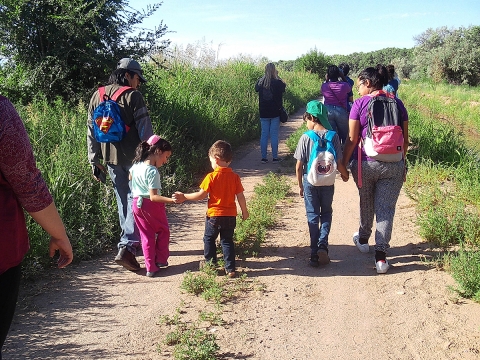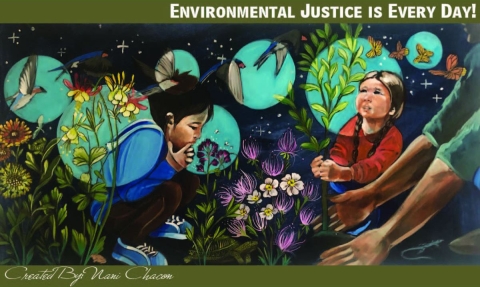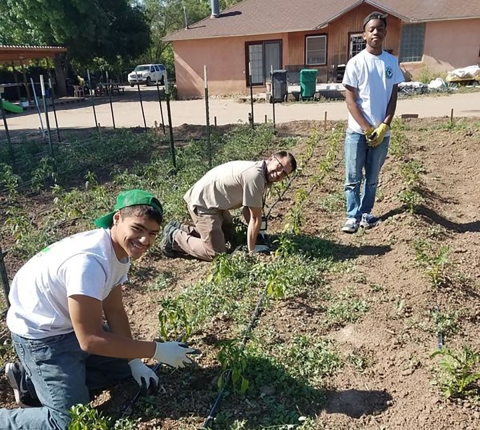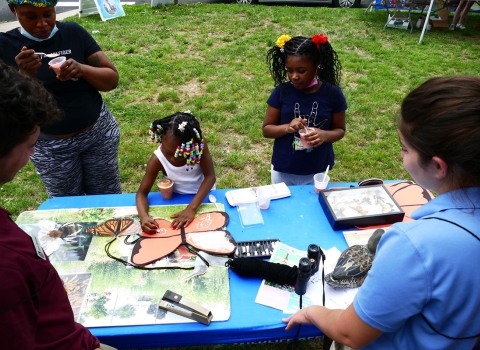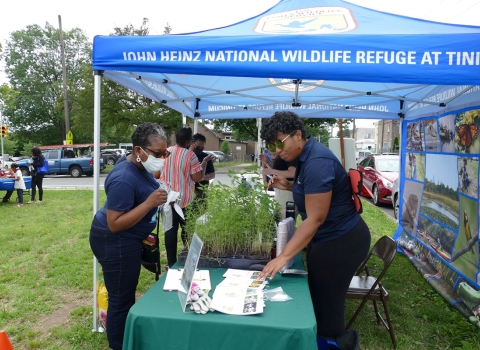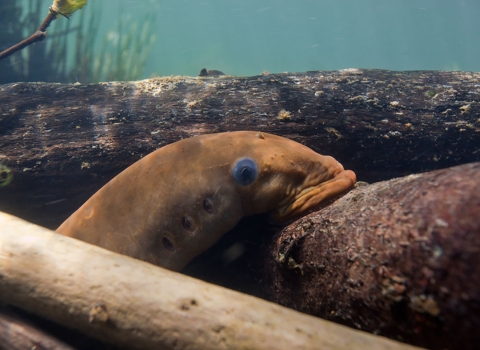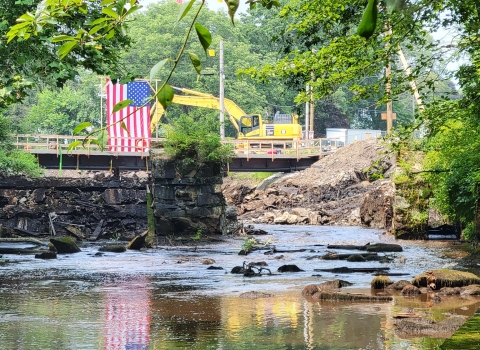The community of Mountain View, in Albuquerque’s South Valley, may seem an unlikely setting for a federally managed wildlife refuge. Beset by some of the worst poverty rates in New Mexico’s largest city, the predominantly Hispanic neighborhood is home to asphalt and concrete manufacturers, a massive sewer treatment plant, sprawling auto salvage lots, and bulk-fuel terminals – along with high levels of air pollution, contaminated groundwater, 47 EPA-regulated sites, and two federal Superfund sites, all within an 11 square-mile area that 6,000 residents call home.
But it is exactly these dynamics that underscore the significance of the role Valle de Oro National Wildlife Refuge is hoping to play in the local social fabric. The refuge was established in 2012 when community members worked with local organizations and the Service to set aside 570 acres stretching along the Rio Grande, on land that had been part of a large dairy farm. The refuge’s establishment disabused notions at the time of using the site to expand the nearby sewage plant, and the refuge now protects the place—the largest remaining tract of undeveloped farmland in the city—as it works to restore ecological health.
Environmental Justice First
The refuge also represents the nation’s first federal public land with a site-specific strategic plan addressing issues of environmental and economic justice.
“The work of the refuge is invaluable to the immediate community. As a first of its kind to address issues that have been ignored for too long, the refuge is extremely important in offering neighbors access to green space while drawing attention and resources and creating opportunities that will help empower the community,” says Richard Moore, a former Mountain View resident and veteran activist who co-chairs the newly created White House Environmental Justice Advisory Council. “And the kinds of issues the refuge is trying to address locally are fortunately now being taken seriously at the highest levels of government.”
Moore is also co-founder of local grassroots organization Los Jardines Institute, which, along with the Friends of Valle de Oro National Wildlife Refuge, and staff of the refuge itself, crafted Valle de Oro’s “Environmental and Economic Justice Strategic Plan.”
The document outlines a number of specific goals, such as engaging in local contamination monitoring and mitigation work, helping facilitate studies of health and pollution remediation, integrating Environmental Justice principles into the refuge’s development, and providing support, services, resources, employment, and other opportunities for refuge neighbors. Another main point of the plan calls for early, meaningful and ongoing community involvement in the refuge’s decision-making process. Altogether, the plan aims to build a place that serves as a premier model for community-based natural and cultural resource management rooted in equity.
To these ends, the refuge, with grant support from the EPA and oversight by its Environmental Justice leadership team, has appointed a program manager to update the strategic plan over the next four years, foster collaboration between the refuge and the Mountain View community, and develop an Environmental Justice curriculum for refuge staff, volunteers, interns, partners, local schools, and the general public.
Community's Refuge
The refuge also hosts an annual Environmental Justice community day each spring, a kind of block party with food, music, educational booths, and crowds of neighbors gathering to discuss issues that impact the local environment and people.
“The whole idea is to involve the community as much as possible, so that they ultimately guide refuge management and development to meet their needs,” says Jennifer Owen-White, who has managed the refuge since it was established nine years ago.
As manager, Owen-White also oversees a number of ecological restoration efforts, from the creation of seasonal wetlands and the restoration of grasslands and upland habitats, to the expansion of the forested riverbank of native cottonwoods and willows known locally as the “bosque.”
This work, too, involves much participation from the immediate community. Many Mountain View residents weighed in on design considerations for habitat features, and local volunteers and youth crews are helping restore more than 500 acres of fallow farmland back to historic conditions as a native Rio Grande floodplain ecosystem.
A Place for Young People
In fact, the refuge is very involved in putting young people to work through partnerships with the Ancestral Lands Conservation Corps, the Rocky Mountain Youth Corps, and the Federal Youth Conservation Corps. In a normal year, more than 100 youth have jobs based out of Valle de Oro as they work on public federal, state, and local lands, and Tribal lands.
“It’s amazing how committed the refuge is to presenting opportunities for young people,” says Dakota Dominguez. A crew supervisor with one of the youth corps programs himself, Dominguez, 28, was hired by the refuge earlier this year as a park ranger and volunteer coordinator, and he continues working closely with youth crews on various conservation projects.
Work in Progress
But, as with ecological restoration work, the evolution of the refuge and its significance in the community will require patience. “It won’t happen overnight,” says Owen-White. “It’s about generational change, which takes committed, intentional effort over years and decades.”
Certainly, the history of the neighborhood reflects this sobering reality. A tranquil but thriving and established agricultural community on the banks of the Rio Grande, Mountain View grew as Albuquerque rapidly began expanding in the 1940s. The area was re-zoned in the 1970s, opening it to industrial development—and to the legacy it wrought.
Today, many residents are skeptical about the quality of the water in the river that feeds the neighborhood’s traditional farm irrigation systems, or “acequias.” And continuing proposals to build more industrial facilities in the area are deeply concerning to members of a community already plagued by some of the county’s highest death rates and shortest life spans. Currently, the Friends group and other community advocates are hoping to get an air quality permit for a proposed asphalt plant on a 61-acre site within two miles of the refuge rescinded at a hearing scheduled for later this year.
“Mountain View residents were instrumental in helping to establish the Valle de Oro National Wildlife Refuge, the first green space in their community,” says Aryn LaBrake, executive director of the Friends group. “While it is disheartening that their only green space and their health is threatened by new polluting industry, the refuge is a huge step in mitigating a local pattern of exploitation evident in far too many vulnerable communities across the country and throughout the world.”
The refuge certainly represents a milestone for the federal agency that manages it. As part of the Service’s growing network of more than 100 urban refuges nationwide helping cities pursue innovative community-based solutions for wildlife conservation while increasing public access to the outdoors in urban settings, Valle de Oro, which is easily accessible to more than half of the state’s entire population, is the first such refuge in the Southwest.
“Valle de Oro is setting an important precedent in fostering positive change, ecologically and socially,” says Regional Director Amy Lueders of the Service’s Arkansas-Rio Grande-Texas Gulf and Lower Colorado Basin Regions. “This is extremely valuable and important work.”
After years of planning, a 10,000-square-foot visitor center at the refuge will open this fall, to feature an amphitheater, classroom, community meeting space, and a career center where young people can learn about and apply for jobs in natural resources conservation. It will also highlight the refuge’s unique mission with a library devoted to Environmental Justice.
By BEN IKENSON, Freelance Writer, Arkansas-Rio Grande-Texas Gulf and Lower Colorado Basin Regions
- This article is from the summer issue of Fish & Wildlife News, our quarterly magazine.
- More Fish and Wildlife News, including how to subscribe to our Fish and Wildlife News email list.

